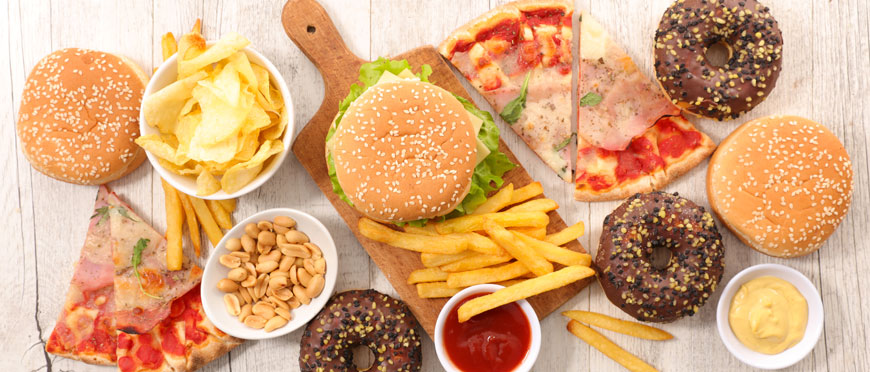One of the cornerstones of any healthy lifestyle change is increasing the amount of real food consumed and limiting the amount of processed food. Real food increases satiety, the feeling of fullness, and limits overeating.
What exactly is processed food?
When we talk about “processed food”, we are talking about:
- cookies
- crackers
- chips
- donuts
- pizza
- cereals
- granola bars
- bars of any kind
- juices
- energy drinks
Anything you find in the aisles of a grocery store is typically “processed food” if it is shelf stable and doesn’t require refrigeration. Processed food doesn’t spoil easily.
The perimeter of the store is usually stocked with “real foods,” which include:
- eggs
- meat
- fish
- poultry
- seafood
- dairy
- nuts
- vegetables
- fruits
Putting things in boxes or cans usually requires them to be shelf stable for an extended period of time. By contrast, real food quickly goes rancid because it contains perishable fats. The manufacturers fool the palate and switch to unhealthy Omega-6 oils in place of healthy Omega-3. Rancid Omega-6 really is hard to identify from nonrancid Omega-6. Rancid Omega-3, however, stenches of dead fish. Of course, this doesn’t fool the inflammatory cascade in your body.
Processing of food allows the big food manufacturers to produce extremely cheap food that is often deficient in micronutrients and minerals due to monocropping and soil nutrient depletion.
Megafarms, which use monocropping, deplete the soil of beneficial microelements in order to maximize production. By 1967, American corn farm was growing nearly three times as much corn as it had thirty years earlier. The monocropped surplus was shared with livestock to increase production; the average dairy cow now produces more than seventy pounds of milk per day, and the top-performing Holsteins produce two hundred pounds per day, a 1,200 percent increase over the 1948 average. Similarly, a typical potato farmer produced about 63 sacks of potatoes for every acre in the 1930s, but by the mid-1960s, it was up to 200 sacks. Maximizing food quantity came at the cost of nutrient density, though, and food began to get blander.
Normally, humans would consider this food bland and disgusting and would reject it. However, the food manufacturers fool our taste buds by engineering flavors and colors that make our palate think that the food is fresh and nutritious. This area of food engineering is highly sophisticated and is designed to evoke emotional responses. The field of flavor engineering combines organic chemistry with engineering, neuroscience, psychography, psychophysics, ethnography, demography, molecular biology, finance, botany, economics, and physiology to produce flavors that specifically increase craving. Eating is a behavior driven by an expectation of pleasure — we crave flavors.
Food palatability, engineering, and increased food variety stimulate appetite, thus delaying satiety and promoting excessive energy intake. There is a robust effect of food palatability and variety on short-term food intake, and increased variety and palatability also cause weight gain in animal models. Food combinations high in sugar, fat, and flavor are hyperpalatable (extra tasty).
- highly palatable meals were 44% larger than the average meal
- activates hedonic motivational pathways
- over time, consumption of a highly palatable diet may lead to reductions in brain reward response capacity
The brain is hardwired to look for the most nutrient dense food, which typically is also the most flavorful. The food engineers have corrupted the natural order of things, though, presenting the palate with nutrient-poor food that simulates nutrient-rich. Once your body realizes what happened an hour later, it’s demanding nutrients and your satiety immediately vanishes. Interestingly, a recent study by Dr. Kevin Hall, from the NIH, demonstrated that a processed-food diet lead to an increased daily intake of about 500 calories when compared to a real food diet, despite similar overall satiety scores.
Processing foods for product standardization by grinding and homogenizing increases the glycemic index of food, even if it is re-configured from a powder into a pellet, because the absorption of finely processed particles is faster. This increased absorption occurs earlier in the gut, presenting less for distal bacterial fermentation. Additionally, global glycemic load is also higher, due to a reduced thermic effect of food (TEF) (the amount of energy expenditure above the basal metabolic rate due to the cost of processing food for use and storage in the body, which is absent if the food has been industrially processed).
- Carbohydrates: 5 to 15% of the calories are burned during digestion.
- Fats: 5 to 15% of the calories are burned during digestion.
- Protein: 20 to 35% of the calories are burned during digestion.
Eating real food is an easy way to eat more nutrient dense food that is more satiating.






